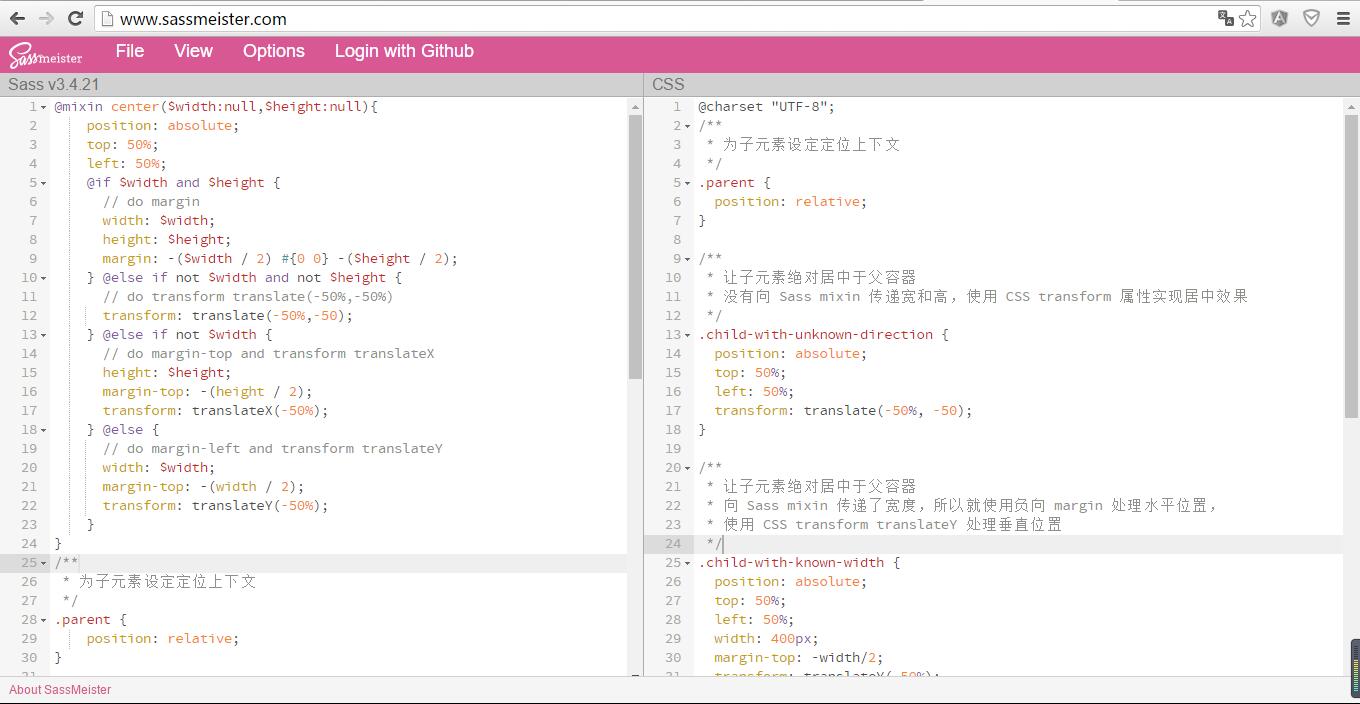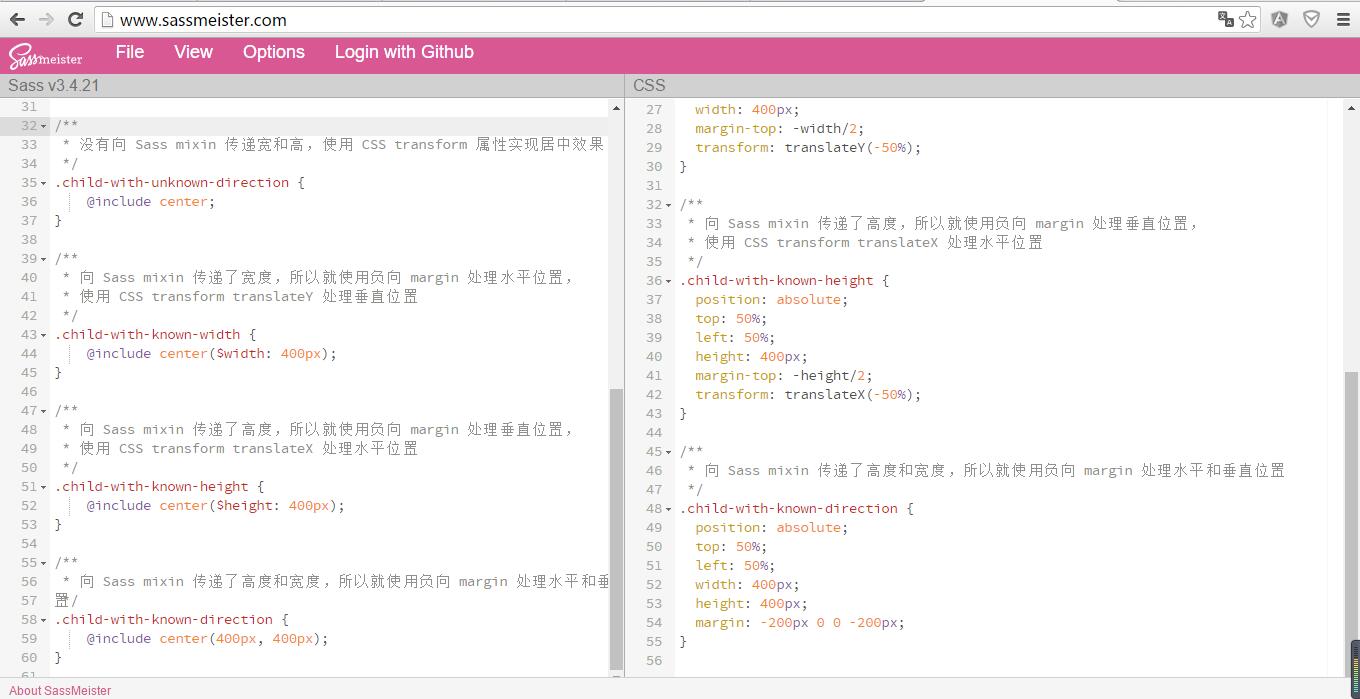实现css水平垂直居中的方法有很多,在这里我简单的说下四种比较常用的方法:
1.使用CSS3中的Flex布局
对于flex,我们要了解的是它是一个display的属性,而且必须要给他的父元素设置flex属性(flex必须配合绝对定位使用!!!!!),除了设置display:flex之外,还有另外两个属性需要设置,分别是justify-content和align-items,他们的意思分别是水平居中和垂直居中。HTML+CSS代码如下:
body { position: absolute; width: 100%; height: 100%; display: flex; justify-content: center; align-items: center; } .parentNode { width: 400px; height: 400px; background: #f00; }
<body> <div class="parentNode"></div> </body>
当需求改变时,比如我们要在此div里面嵌套一个div,根据我上面提到的,要想子DIV垂直水平居中,我们也要给父DIV同样这样设置
<!DOCTYPE html> <html lang="en"> <head> <meta charset="UTF-8"> <title>Document</title> <style> * { margin: 0; padding: 0; } body { position: absolute; // flex必须配合absolute使用才会生效 width: 100%; height: 100%; display: flex; justify-content: center; align-items: center; } .parentNode { width: 400px; height: 400px; background: #f00; position: relative; // 这里必须用relative 原因是 相对于 body这个父标签定位 如果用absolute会找上级的relative,如果没有,就到顶级的document display: flex; justify-content: center; align-items: center; } .childNode { width: 200px; height: 200px; background: #fff; } </style> </head> <body> <div class="parentNode"> <div class="childNode"></div> </div> </body> </html>

2.使用CSS3中的transform
.parentNode { width: 400px; height: 400px; background: #f00; position: absolute; left: 50%; top: 50%; transform: translate(-50%, -50%); }
3.当你知道元素的width与height时,使用CSS2中的最普通不过的margin
.parentNode { width: 400px; height: 400px; background: #f00; position: absolute; left: 50%; top: 50%; margin: -200px 0 0 -200px; }
4.使用比较特殊的margin:auto
.parentNode { width: 400px; height: 400px; background: #f00; overflow: auto; margin: auto; // 在标准流的情况下,让 margin-top 以及 margin-bottom 都为0 position: absolute; top: 0; left: 0; bottom: 0; right: 0; // 使浏览器对其元素所在的区域内重新渲染,四个值都设为0目的是让整个窗口都为该元素的重新渲染区域,之后margin-top以及margin-bottom都相等 }
现在让我们来使用强大的SASS重构一下这几个样式,先拿flex开刀吧,
@mixin center { display: flex; justify-content: center; align-items: center; } body { position: absolute; width: 100%; height: 100%; @include center;
.parentNode { width: 400px; height: 400px; background: #f00; position: relative; @include center;
.childNode { width: 200px; height: 200px; background: #fff; } } }
如果你的整个网站中有几处小样式类似,比如颜色,字体等,在 Sass 可以使用"$"变量来统一处理,那么这种选择还是不错的。但当你的样式变得越来越复杂,需要重复使用大段的样式时,使用变量就无法达到我们目了。这个时候 Sass 中的混合宏就会变得非常有意义,@mixin 是用来声明混合宏的关键词,有点类似 CSS 中的 @media、@font-face 一样。center 是混合宏的名称。大括号里面是复用的样式代码。@include为调用混合宏。除了声明一个不带参数的混合宏之外,还可以在定义混合宏时带有参数,并且在里面还可以写更加复杂的逻辑。
下面我将会用到if else语句以及@mixin混合宏来封装我们上面的第2,3,4方法。
我们的思路是先将DIV的左上角绝对定位到容器的中心位置,然后为 mixin 添加两个可选参数($width,$height),分别代表元素的宽高,如果传递了参数,那么就使用负向 margin 的方法实现居中;如果没有传递参数,就使用 CSS3的transform 的方法。
/** * 为子元素设定定位上下文 */ .parent { position: relative; } /** * 让子元素绝对居中于父容器 * 没有向 Sass mixin 传递宽和高,使用 CSS transform 属性实现居中效果 */ .child-with-unknown-direction { @include center; } /** * 让子元素绝对居中于父容器 * 向 Sass mixin 传递了宽度,所以就使用负向 margin 处理水平位置, * 使用 CSS transform translateY 处理垂直位置 */ .child-with-known-width { @include center(400px); } /** * 让子元素绝对居中于父容器 * 向 Sass mixin 传递了高度,所以就使用负向 margin 处理垂直位置, * 使用 CSS transform translateX 处理水平位置 */ .child-with-known-height { @include center($height: 400px); } /** * 让子元素绝对居中于父容器 * 向 Sass mixin 传递了高度和宽度,所以就使用负向 margin 处理水平和垂直位置 */ .child-with-known-direction { @include center(400px, 400px); }
现在我们开始封装@mixin,由上面的CSS分析知,要实现居中必须先让元素绝对定位
@mixin center($ null, $height: null) { position: absolute; top: 50%; left: 50%; }
然后根据下面的逻辑搭建@mixin的骨架
| width | height | solution |
|---|---|---|
| null | null | translate |
| defined | defined | margin |
| defined | null | margin-left + translateY |
| null | defined | margin-right + translateX |
@mixin center($null,$height:null){ display: flex; justify-content: center; align-items: center; @if $width and $height { // do margin } @else if not $width and not $height { // do transform translate(-50%,-50%) } @else if not $width { // do margin-top and transform translateX } @else { // do margin-left and transform translateY } }
最后我们把具体的代码插入到不同的条件中去
@mixin center($null,$height:null){ position: absolute; top: 50%; left: 50%; @if $width and $height { // do margin width: $width; height: $height; margin: -($height / 2) #{0 0} -($width / 2); //这里如果直接写 0 0 他会编译为 margin: xx 0 xx 而不是 margin:xx 0 0 xx,所以用 #{0 0}
} @else if not $width and not $height { // do transform translate(-50%,-50%) transform: translate(-50%,-50); } @else if not $width { // do margin-top and transform translateX height: $height; margin-top: -(height / 2); transform: translateX(-50%); } @else { // do margin-left and transform translateY width: $width; margin-top: -(width / 2); transform: translateY(-50%); } }
最后我们可以通过Koala软件离线编译也可以通过http://www.sassmeister.com/在线编译,下面是编译好的结果
@charset "UTF-8";
/**
* 为子元素设定定位上下文
*/
.parent {
position: relative;
}
/**
* 让子元素绝对居中于父容器
* 没有向 Sass mixin 传递宽和高,使用 CSS transform 属性实现居中效果
*/
.child-with-unknown-direction {
position: absolute;
top: 50%;
left: 50%;
transform: translate(-50%, -50);
}
/**
* 让子元素绝对居中于父容器
* 向 Sass mixin 传递了宽度,所以就使用负向 margin 处理水平位置,
* 使用 CSS transform translateY 处理垂直位置
*/
.child-with-known-width {
position: absolute;
top: 50%;
left: 50%;
400px;
margin-top: -width/2;
transform: translateY(-50%);
}
/**
* 让子元素绝对居中于父容器
* 向 Sass mixin 传递了高度,所以就使用负向 margin 处理垂直位置,
* 使用 CSS transform translateX 处理水平位置
*/
.child-with-known-height {
position: absolute;
top: 50%;
left: 50%;
height: 400px;
margin-top: -height/2;
transform: translateX(-50%);
}
/**
* 让子元素绝对居中于父容器
* 向 Sass mixin 传递了高度和宽度,所以就使用负向 margin 处理水平和垂直位置
*/
.child-with-known-direction {
position: absolute;
top: 50%;
left: 50%;
400px;
height: 400px;
margin: -200px 0 0 -200px;
}

